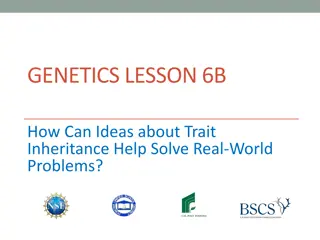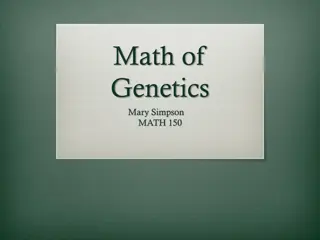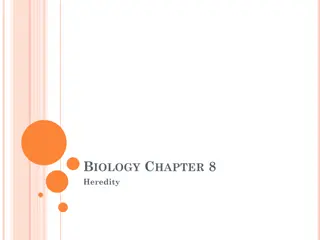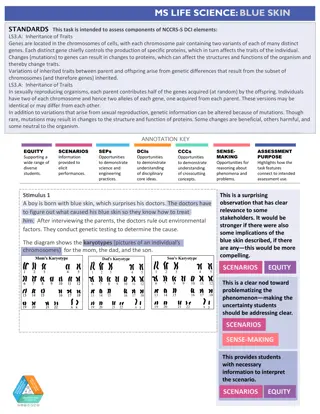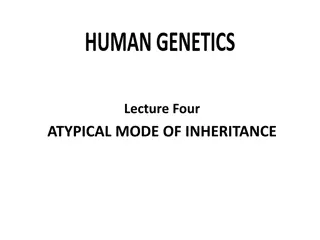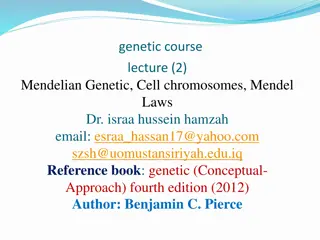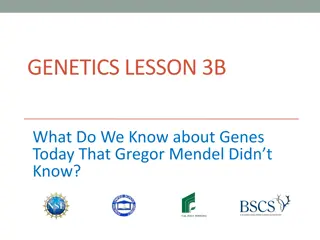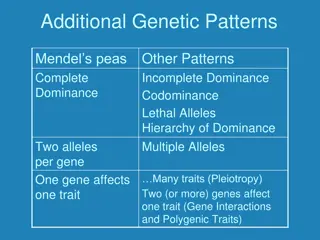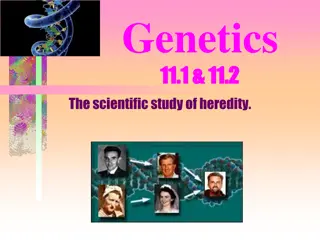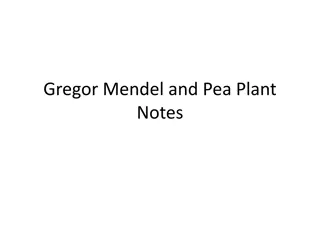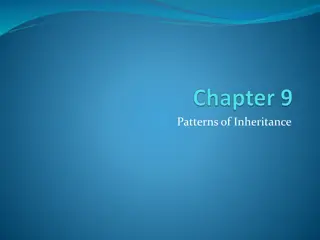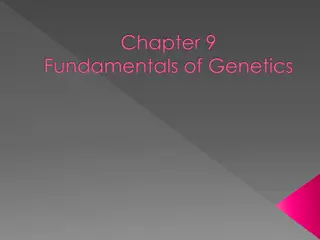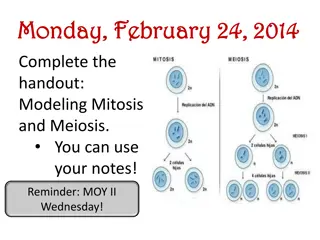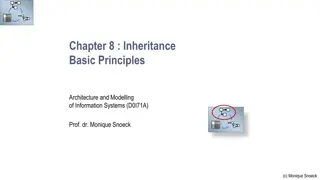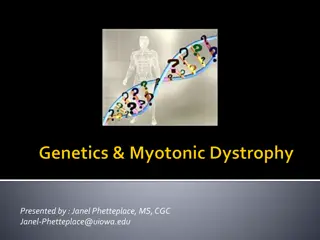Understanding Genetic Inheritance: Going Beyond Mendel
Exploring genetic inheritance beyond Mendel's principles, this content delves into topics like incomplete dominance, codominance, pleiotropy, epistasis, and multiple alleles. Discover how genes interact to shape phenotypes and learn about interesting genetic phenomena like Marfan syndrome and the ABO blood type system.
Download Presentation

Please find below an Image/Link to download the presentation.
The content on the website is provided AS IS for your information and personal use only. It may not be sold, licensed, or shared on other websites without obtaining consent from the author. Download presentation by click this link. If you encounter any issues during the download, it is possible that the publisher has removed the file from their server.
E N D
Presentation Transcript
Chromosomes and genes 12.1. Going Beyond Mendel
A. Dominance Has Degrees 1. Incomplete dominance: offspring show traits intermediate between two parental phenotypes. a. Red and white-flowered four o'clocks produce pink-flowered offspring. (Fig. 12.1) R1R1 x R2R2 R1R2 (pink) b. Incomplete dominance has a biochemical basis; level of gene-directed protein production may be between that of the two homozygotes. c. One allele of a heterozygous pair only partially dominates expression of its partner. d. This does not support a blending theory; parental phenotypes reappear in F2 generation.
2. Codominance is a pattern of inheritance in which both alleles of a gene are fully expressed. a. A person with AB blood has both A and B antigens on their red blood cells. b. With codominance, both alleles produce an effective product.
B. A Gene That Controls Many Traits 1. Pleiotropy: a single gene exerts an effect on many aspects of an individual's phenotype. a. Marfan syndrome: a mutant gene is unable to code for production of a normal protein, fibrillin. b. Results in the inability to produce normal connective tissue. c. Individuals with Marfan syndrome tend to be tall and thin with long legs, arms, and fingers; are near-sighted; and the wall of their aorta is weak.
C. Genes That Interact 1. More than one pair of genes may interact to produce the phenotype. (An interaction between these genes affect the phenotype) 2. Epistasis: absence of expected phenotype as a result of masking expression of one gene pair by the expression of another gene pair. a. The homozygous recessive condition masks the effect of a dominant allele at another locus. b. Crossing sweet pea plants produces purple; F2 generation has a 9:7 rather than 9:3:3:1 dihybrid ratio; explained by homozygous recessive blocking production of metabolic enzyme. (Fig. 12.2) AAbb x aaBB AaBb (purple) c. Albino animals inherit allelic pair (aa) preventing production of melanin, expression of eye, hair color.
Q: Write short notes on the followings: 1- Epistasis 2- Pleiotropy
D. Multiple Alleles 1. There may be more than two alleles for one locus, but each individual inherits only two alleles. 2. A multiple allele system in peppered moths has three possible alleles for wing c ;three .3) 3. The ABO system of human blood type involves three alleles. 4. As a result, there are four possible phenotypes or blood types: A, B, AB, and O.
E. Environment Affects the Phenotype 1. Both genotype and environment affect phenotype; relative importance of both influences vary. 2. Aquatic environment influences the phenotype of water buttercup, Ranunculus peltatus.(part above water, other submerged) 3. Temperature can affect the phenotypes of some plants (e. g., primroses white flowers above 32c, red flowers at 24c ) and animals (e. g., Siamese cats, Himalaya rabbits). (Fig. 12.4)
F. Genes That Add Up 1. Polygenic inheritance occurs when a trait is controlled by several allelic pairs at different loci. 2. Allelic pairs at different loci on a chromosome or on different chromosomes all control one trait. 3. Gene alleles can be contributing or noncontributing. 4. Contributing alleles have an additive effect, resulting in quantitative variations. 5. Examples include seed color in wheat (Fig. 12.5 aabbcc) and skin color (sun effect) and height in humans (nutrition effect). 6. Polygenic traits are subject to environmental effects that cause intermediate phenotypes; so they produce continuous variations whose frequency distribution forms a normal (bell- shaped) curve.
12.2. Chromosomes Contain Genes (p. 192) A. Chromosomal Theory of Inheritance 1. Genes are located on chromosomes. 2. Independently proposed in 1902 by Theodor Boveri and Walter S. Sutton. 3. Accounts for the similarity of chromosomal behavior during meiosis and fertilization. 4. Theory is supported by the following observations: a. Both chromosomes and factors (now called alleles) are paired in diploid cells. b. Chromosomes and alleles of each pair separate during meiosis so gametes have one-half. c. Chromosomes and alleles of separate independently; gametes contain all combinations. d. Fertilization restores diploid chromosome number and paired condition for alleles in zygote.
B. Sex Chromosomes Determine Gender 1. In most animal species, chromosomes can be categorized as two types: a. Autosomes are nonsex chromosomes that are the same number and kind between sexes. b. Sex chromosomes differ in number and kind between males and females. 2. Sex chromosomes in the human female are XX; those of the male are XY. 3. Males produce X-containing and Y- containing gametes; males determine the sex of offspring. 4. Besides genes that determine sex, sex chromosomes carry genes for traits unrelated to sex. 5. X-linked gene is any gene located on X chromosome; used to describe genes on X chromosome that do not control a sexual feature and that are missing on the Y chromosome.
C. Genes That Are on the X Chromosomes 1. Work by Thomas Hunt Morgan (Columbia University) confirmed genes were on chromosomes. 2. Experiments involved fruit flies with XY system similar to human system. a. Newly discovered mutant male fruit fly had white eyes ( XrY ). b. Cross of white-eyed male with dominant red-eyed female yield expected 3:1 red-to-white ratio; however, all white- eyed flies were males! c. An allele for eye color on the X but not Y chromosome supports the results of the cross. (Fig. 12.6b) XR XR x XrY d. Behavior of allele corresponds to chromosome, confirming chromosomal theory of inheritance.
3. Doing X-Linked Problems a. X-linked alleles are designated as superscripts to X chromosome. b. Heterozygous females are carriers; they do not show the trait but can pass it on. XR Xr c. Males are never carriers but express the one allele on the X chromosome. d. One form of color-blindness is X- linked recessive.
D. Genes Are Linked 1. Fruit flies have four pairs of chromosomes to hold thousands of genes; Sutton concluded each chromosome must hold many genes. 2. All alleles on a chromosome form a linkage group that stays together except when crossing over. 3. Linked alleles do not obey Mendel's laws because they tend to go into the gametes together. 4. Crosses involving linked genes do not give same results as unlinked genes. (Fig. 12.7) 5. Heterozygote forms only two types of gametes and produces offspring with only two phenotypes. 6. Crossing-over causes recombinant gametes and at fertilization, recombinant phenotypes. (Figs. 12.7b, 12.8)
12.3. Chromosomes Undergo Mutations (p. 196) A. Mutations 1. Changes in chromosomes or genes that pass to offspring if they occur in gametes. 2. Mutations increase the amount of variation among offspring. 3. Chromosomal mutations include changes in chromosome number and structure.
B. Changing Chromosome Number 1. Monosomy occurs when an individual has only one of a particular type of chromosome. 2. Trisomy occurs when an individual has three of a particular type of chromosome. 3. Nondisjunction is the failure of chromosomes to separate; it is more common during meiosis I than meiosis II; it can occur in mitosis. 4. Monosomy and trisomy occur in plants and animals; in autosomes of animals, it is generally lethal. The survivors are characterized by a distinctive set of physical and mental abnormalities called a syndrome 5. Nonlethal human monosomies and trisomies include the following: a. Turner syndrome: monosomy where the individual has single X chromosome. b. Down syndrome is most common trisomy among humans; it involves chromosome 21.
6. Polyploidy: offspring end up with more than two complete sets of chromosomes. a. Terms indicate how many sets of chromosomes are present (triploid [3n], tetraploids [4n], etc.). b. Polyploidy does not increase variation in animals??; it is a major evolutionary mechanism in plants. c. Hybridization in plants can result in doubled number of chromosomes; an even number of chromosomes can undergo synapsis during meiosis; successful polyploidy results in a new species. (Fig. 12.9)
C. Changing Chromosomal Structure 1. Environmental factors including radiation, chemicals, and viruses, can cause chromosomes to break; if the broken ends do not rejoin in the same pattern, this causes a change in chromosomal structure. 2. Inversions: a segment that has become separated from the chromosome is reinserted at the same place but in reverse; the position and sequence of genes are altered. (Fig. 12.10a) 3. Translocations: a chromosomal segment is removed from one chromosome and inserted into another, nonhomologous chromosome. (Fig. 12.10b) . Translocation heterozygotes usually have reduced fertility due to production of abnormal gametes. 4. Deletions are a type of mutation in which an end of a chromosome breaks off or when two simultaneous breaks lead to the loss of a segment. (Fig. 12.10c)
a. Even if only one member of pair of chromosomes is affected, a deletion can cause abnormalities. b. Cri du chat syndrome is deletion in which an individual has a small head, is mentally retarded, has facial abnormalities, and abnormal glottis and larynx resulting in a cry resembling that of a cat. 5. Duplications area doubling of a chromosomal segment. (Fig. 12.10d) a. A broken segment from one chromosome can simply attach to its homologue. b. Unequal crossing-over may occur. 6. Multiple copies of genes can mutate differently and provide additional genetic variation for a species. --------------------------------------------------------------------- -
I hope with the better Chromosomes and Genes


